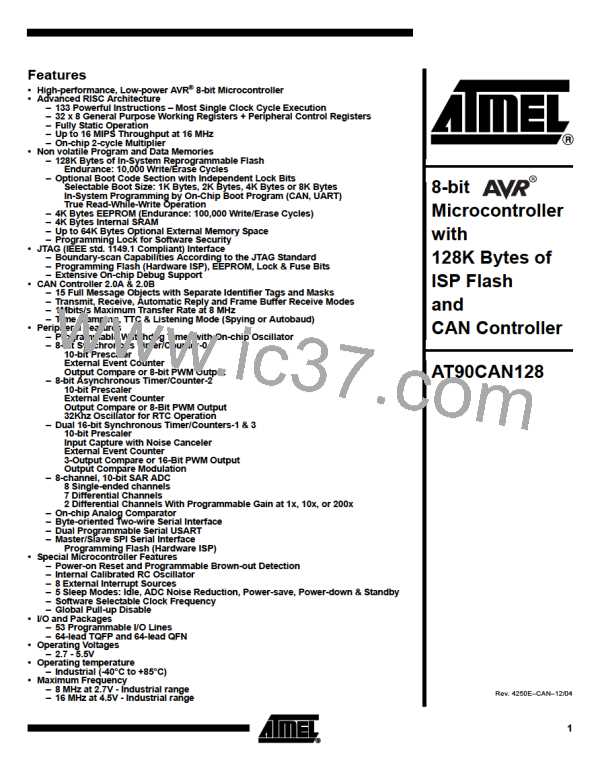machine that uses 2, 8 or 16 states depending on mode set by the state of the UMSELn,
U2Xn and DDR_XCKn bits.
Table 76 contains equations for calculating the baud rate (in bits per second) and for
calculating the UBRRn value for each mode of operation using an internally generated
clock source.
Table 76. Equations for Calculating Baud Rate Register Setting
Equation for Calculating
Baud Rate(1)
Equation for Calculating
UBRRn Value
Operating Mode
fCLKio
Asynchronous Normal
mode (U2Xn = 0)
fCLKio
BAUD = -----------------------------------------
16(UBRRn + 1)
UBRRn = ----------------------- – 1
16BAUD
fCLKio
fCLKio
Asynchronous Double
Speed mode (U2Xn = 1)
BAUD = --------------------------------------
8(UBRRn + 1)
UBRRn = -------------------- – 1
8BAUD
fCLKio
fCLKio
Synchronous Master
mode
BAUD = --------------------------------------
2(UBRRn + 1)
UBRRn = -------------------- – 1
2BAUD
Note:
BAUD
fclkio
1. The baud rate is defined to be the transfer rate in bit per second (bps)
Baud rate (in bits per second, bps).
System I/O Clock frequency.
UBRRn Contents of the UBRRnH and UBRRnL Registers, (0-4095).
Some examples of UBRRn values for some system clock frequencies are found in Table
84 (see page 195).
Double Speed Operation
(U2X)
The transfer rate can be doubled by setting the U2Xn bit in UCSRnA. Setting this bit
only has effect for the asynchronous operation. Set this bit to zero when using synchro-
nous operation.
Setting this bit will reduce the divisor of the baud rate divider from 16 to 8, effectively
doubling the transfer rate for asynchronous communication. Note however that the
Receiver will in this case only use half the number of samples (reduced from 16 to 8) for
data sampling and clock recovery, and therefore a more accurate baud rate setting and
system clock are required when this mode is used. For the Transmitter, there are no
downsides.
External Clock
External clocking is used by the synchronous slave modes of operation. The description
in this section refers to Figure 84 for details.
External clock input from the XCKn pin is sampled by a synchronization register to mini-
mize the chance of meta-stability. The output from the synchronization register must
then pass through an edge detector before it can be used by the Transmitter and
Receiver. This process introduces a two CPU clock period delay and therefore the max-
imum external XCKn clock frequency is limited by the following equation:
fCLKio
fXCKn < ---------------
4
Note that fclkio depends on the stability of the system clock source. It is therefore recom-
mended to add some margin to avoid possible loss of data due to frequency variations.
174
AT90CAN128
4250E–CAN–12/04

 ATMEL [ ATMEL ]
ATMEL [ ATMEL ]